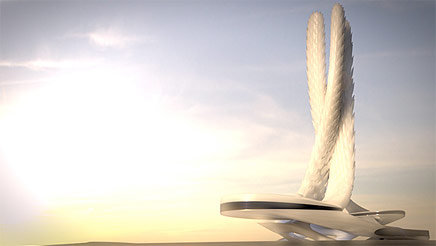Wednesday, October 13. 2010
Via It's Nice That
-----


The Tate Modern have always challenged people’s perceptions of art throughout The Unilever Series (now in it’s eleventh year), from Olafur Eliasson’s The Weather Project to Doris Salcedo’s Shibboleth they have always got people talking and the latest installation by Chinese artist Ai Weiwei is no exception. In his latest work 1000 square metres of The Turbine Hall’s floor are now covered in more than 100 million individually handmade replica sunflower seeds. (Read more)
www.aiweiwei.com
www.tate.org.uk
Wednesday, October 06. 2010
-----
For its new virtual museum, Adobe wanted more than a website designer: It wanted a forward-thinking architect who could make the space feel "physical." It turned to Filippo Innocenti, co-founder of Spin+ and an associate architect at Zaha Hadid Architects. via Arch Record
Personal comment:
11 years after La_Fabrique and 6 after MIX-m (for MIXed museum, at the MAMCO and later at CAC), Adobe is lauching its digital museum designed by Filippo Innocenti & Zaha Hadid. Thank you the "avant-garde" ;) ...
Is this the time of the "slope of enlightment" for digital museums, opened 24/7 worldwide and dedicated to digital content?
Monday, March 08. 2010
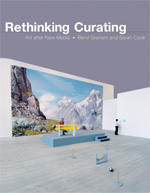
Colleagues and friends Sarah Cook and Beryl Graham have just published Rethinking Curating: Art After New Media. I had the privilege of writing the Foreword for the book, and this is, in part, how I discuss their thesis.
“Graham and Cook strategically define so-called new media as a set of behaviors, not as a medium. Once you go down this road, it becomes readily apparent that a similar strategy is equally useful for much of contemporary art. At one time, the new media of photography both changed the aesthetic understanding of painting and participated in the creation of a cultural understanding of (fixed) time and representation. At another time, the new media of video changed the aesthetic understanding of film while participating with television in the creation of a cultural understanding of (real) time and distance. The art most recently known as “new media” changes our understanding of the behaviors of contemporary art precisely because of its participation in the creation of a cultural understanding of computational interactivity and networked participation. In other words, art is different after new media because of new media–not because new media is “next,” but because its behaviors are the behaviors of our technological times.”
It is perhaps wishful thinking that this book will end the eternal recurrence of the same set of questions about what is new media, but it is a huge step forward.
“In Rethinking Curating, the sheer depth and breadth of intelligent reflection among a dedicated, global group of loosely aligned peers belie every summative, simplistic question or statement one has heard or made. “How much does it cost?” “What’s new about it?” “Why is it art?” “What’s next?” “It’s about process.” “It’s computational.” “It crosses boundaries.” “It’s new.” These questions and statements are not “bad,” but in this book Beryl and Sarah give them the context they deserve–the context necessary to move on to the real-world questions and issues of working with dynamic and emerging contemporary art.”
Buy it. Read it. Enjoy it. Ask some new and different questions.
-----
Via Northern Lights
Personal comment:
Following an earlier post about the same book, some short developments here by Steve Dietz.
Friday, July 31. 2009
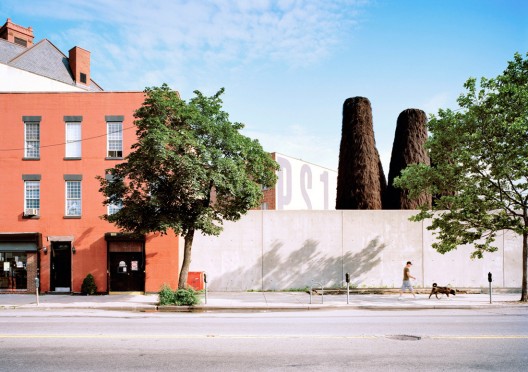
A few months ago we presented you the winning entry for this years YAP competition for the P.S.1 summer installation, awarded to MOS Architects (Michael Meredith, Hilary Sample) as we reported earlier.
This competition has been a field for experimentation on digital manufacturing, new materials and new construction techniques -all under a tight budget-, as we saw in 2008 with the P.F.1 by WORKac.
To keep the courtyard fresh, a series of “hut” like structures conformed by inverted catenaries (part of an on going research by the practice) acting as chimneys: The faux fur that covers them collects heat from the sun, transfering it to the air inside the huts creating a chimney effect that keeps air flowing to cool the lower level.
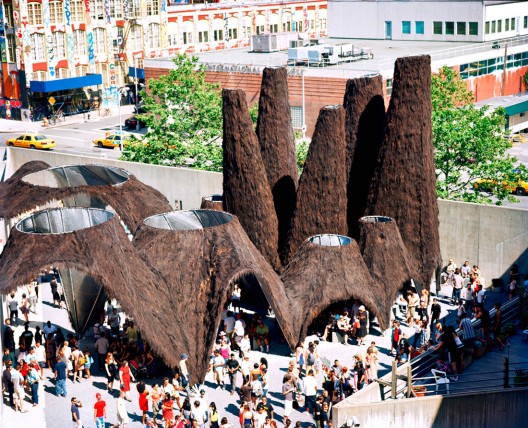
The resulting space corresponds to the after-party concept envisioned by MOS:
The main purpose of the afterparty is to provide a relaxing environment, as compared to the earlier venue, where the atmosphere is usually more frenetic. During an afterparty people often sit down, relax, and chat freely, meet new people in a more controlled setting. If the original party was one that continued until late at night, the afterparty will often include a morning snack, which usually counts as breakfast. …. Possibly in contrast to relaxation, the afterparty can provide a chance for people to get away from the eyes of people who were overseeing the main party. This tends to be more common in events such as school balls where alcohol consumption is not allowed, and provides a location where the partygoers will be allowed to drink. In this case, the afterparty may turn out to be more lively than the main party, as the people are freed from the restrictions that were placed on them during the main party.
All photos by © Florian Holzherr. See more after the break:
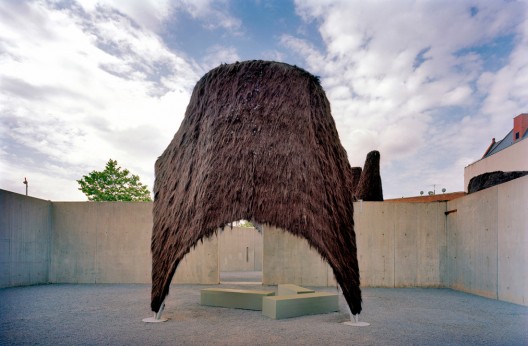

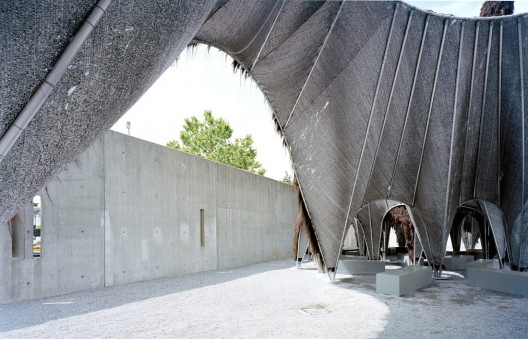
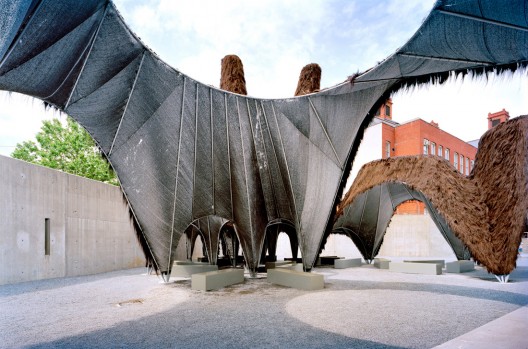
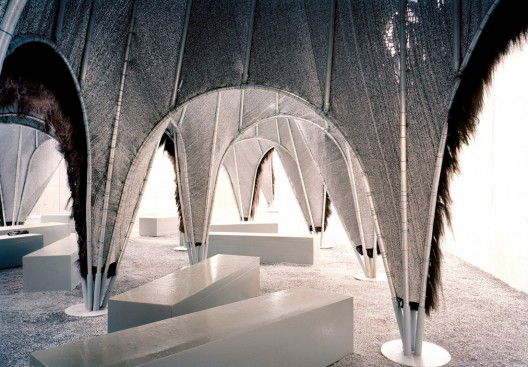
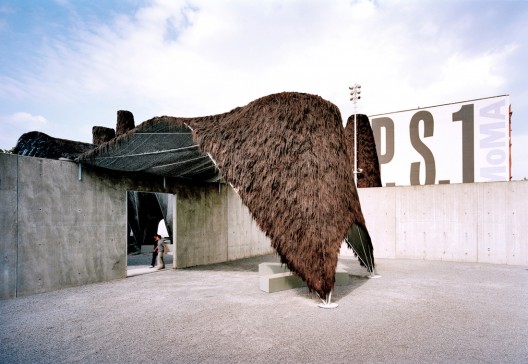

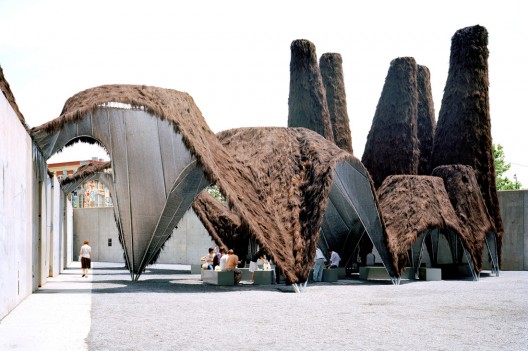

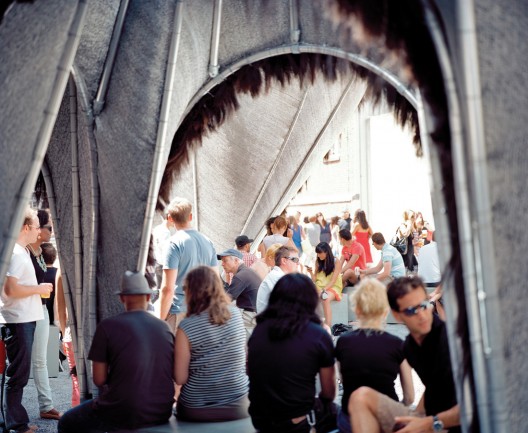
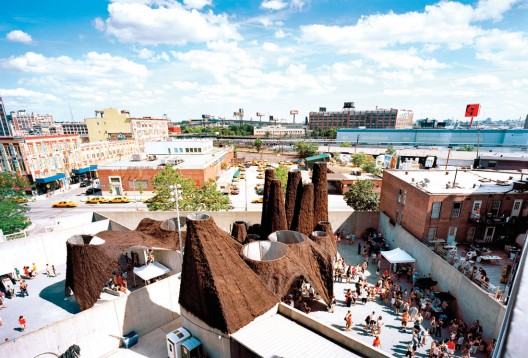

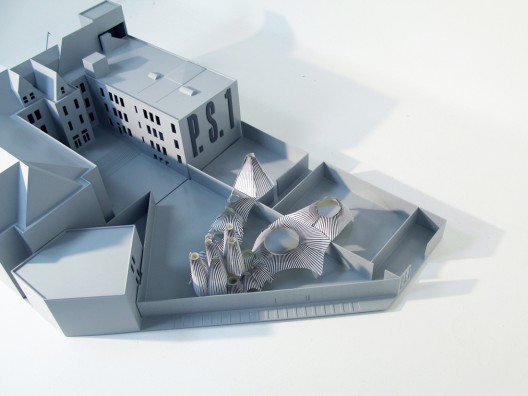
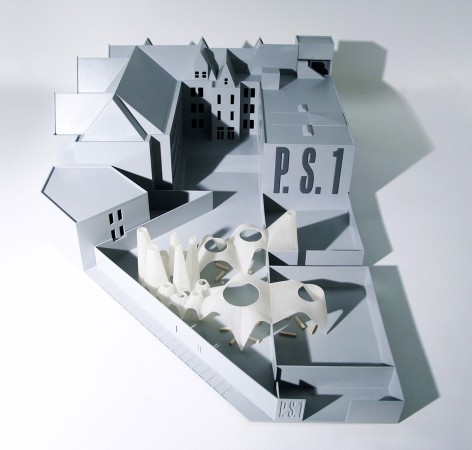
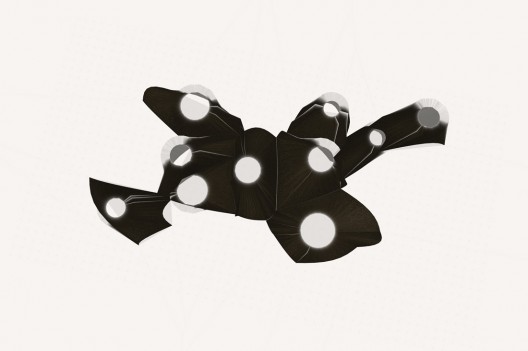
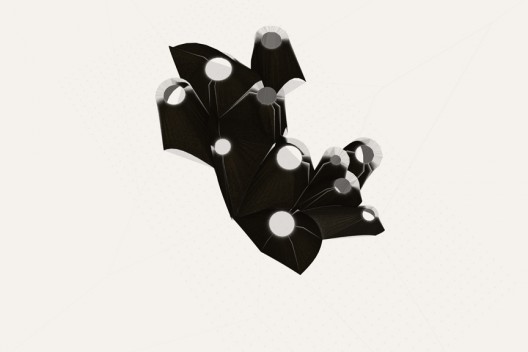
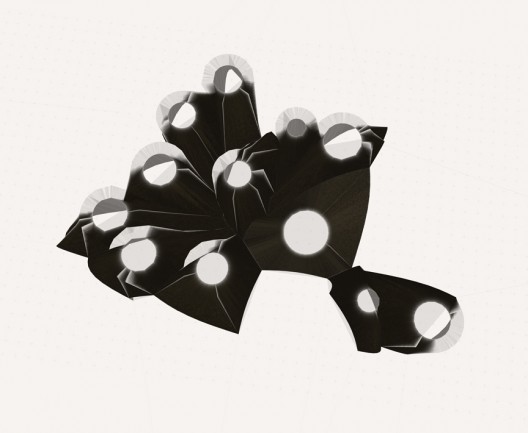
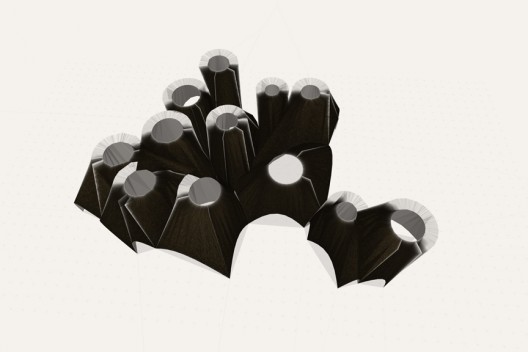 
-----
Via ArchDaily
Personal comment:
Un mélange entre hi-tech génératif (+ ou -) et vernaculaire (+ ou - tentes nomades mongoles (?)), avec un discours sur la gestion des fluxs thermiques évoquant clairement les "architectures sans architectes".
Et un exemple de plus de l'utilisation renouvelée des pavillons comme support de statements (traditionnel celui-ci, puisque le PS1 de New York est un des premiers à avoir relancé le style). Les projets de MOS sont à regarder sur leur site, tout cela a l'air assez intéressant.
Wednesday, May 20. 2009
I've stopped counting the number of emails i received about my latest flickr set titled AUTO. SUEÑO Y MATERIA [AUTO. DREAM AND MATERIAL] . Yes, my friends, it's an exhibition about cars. It's quite spectacular, it's overwhelming and you can visit it until September 21 at Laboral Centro de Arte y Creación Industrial in Gijón, Spain. Over works 100 explore, each in their own way, the relationship between car culture and art creation in recent decades. 100 works that's a lot to write about so i'll start slowly with a first piece i saw at LABoral. A more detailed report will come soon(ish).
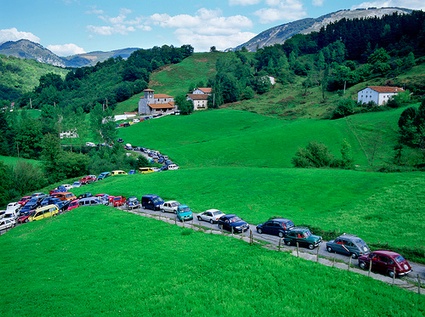
Maider López, Ataskoa desde baserri, 2005
In 2005, Maider López bought advertising space in the press, he had leaflets distributed and posters glued on walls. His objective was to invite car drivers to come and create an artificial traffic jam on the slopes of the Aralar mountains in the North of Spain. On the 18th of September 2005, 160 cars (with approximately 425 people) joined the jam from 11am. until 3pm. The artist's team directed the traffic and documented the event.
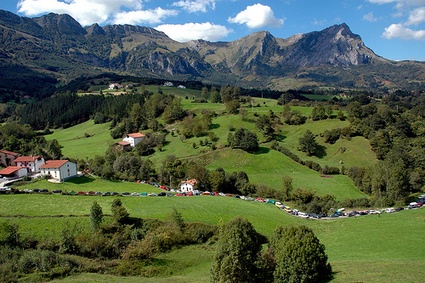
Maider López, Ataskoa Aralar, 2005
The photographs document an absurd confrontation between the urban and the rural, an extravagant Waiting for Godot, which today resonates with an added layer of ecological threat.
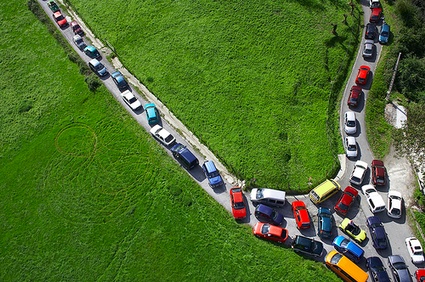
Maider López, Ataskoa aérea, 2005
All images courtesy Laboral Centro de Arte y Creación Industrial.
-----
Via WMMNA
Personal comment:
Ràs de particulier. L'installation "traffic jam" en montagne est tout simplement assez efficace...
Wednesday, April 08. 2009

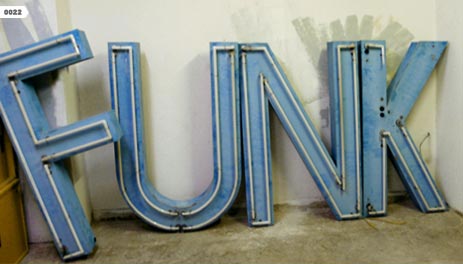

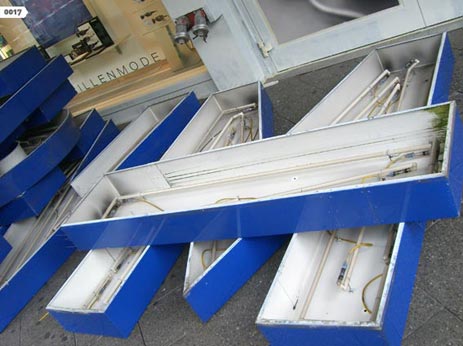
The aim of the Buchstabenmuseum (Museum of Letters, Characters and Typefaces) is the preservation and documentation of letters, regardless of culture, language and font systems. Letters stand at the interface between written and visual culture. They are the basic elements of all semiotic textual traditions and written communication.
Letters are ciphers with characteristic shapes and diverse materiality. They carry images, they flow together as tattoos, or can be savored as pasta and pastries. As a result of the increasing homogenization of the urban landscape quality crafted letters and signs are vanishing from public spaces. Due to the disappearance of traditional companies, and also due to revisions of wordmarks and the rise of the Corporate Logo, regional and historic characters become extinct and are lost.
The Museum of Letters works both as a »recycling« company as well as an archive. The museum collects objects that semiotically act as signifiers in the ABC, that carry meaning independent of their material embodiment, in their diversity of functions and across the whole aesthetic bandwidth.
Planed is a museum space in the traditional sense with unconventional exhibits. The Museum of Letters wants to awaken the public’s interest and awareness in typography, and the collection itself. So far there is no comparable museum dealing exclusively with the letter as a contentfree sign.
The magic of the museum unfolds in the detachment of the objects from their actual context, and in future will delight many visitors, from first graders to academic theorists and street artists to design enthusiasts.
Berlin
-----
Via Manystuff
Personal comment:
Un probablement futur beau musée dédié à la lettre et à la typographie (mais avec une approche pas trop technique et plutôt très visuelle), à Berlin.
Tuesday, November 04. 2008
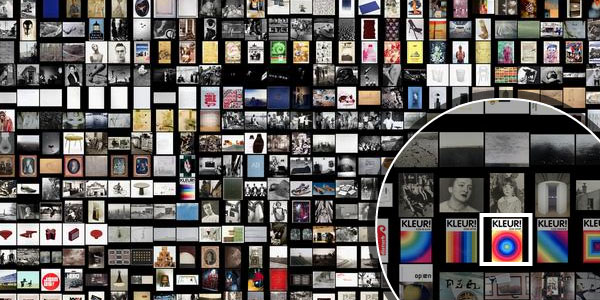
The new SFMOMA ArtScope [sfmoma.org] has been designed for wandering, for the chance discovery of artworks visitors might not have encountered before. The visual browsing tool based on Stamen's Modest Maps tile engine, features more than 3,500 objects from the SFMOMA collection, arranged in a continuous, map-like grid. Users can zoom in on an eye-catching image, search by keyword or artist, or just have a look around, while zoomed views of artworks can even be deep linked.
Reminds me a bit of Microsoft's PhotoSynth. Thnkx Tom.
Thursday, October 23. 2008
In the context of the exhibition theanyspacewhatever at the Guggenheim Museum NY, Douglas Gordon will "deploy time as medium" and Hans-Ulrich Obrist will discuss 24h on time. Shall we speak about dimensional interferences? P_
-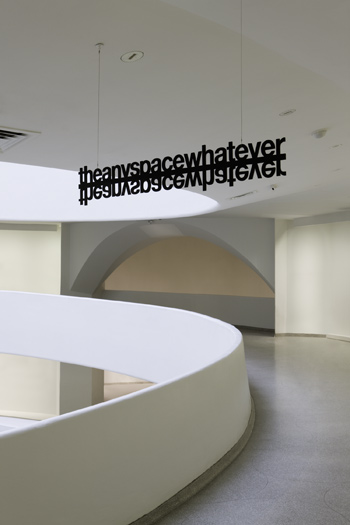
theanyspacewhatever
Oct 24, 2008 - Jan 7, 2009
Solomon R. Guggenheim Museum
1071 5th Ave (at 89th St)
New York, NY
-
Originating with a desire to present a contemporary group exhibition that would capture the spirit of the art that emerged during the early 1990s, this presentation has evolved into a collaborative venture among ten artists who share certain strategies and sensibilities: Angela Bulloch, Maurizio Cattelan, Liam Gillick, Dominique Gonzalez-Foerster, Douglas Gordon, Carsten Höller, Pierre Huyghe, Jorge Pardo, Philippe Parreno, and Rirkrit Tiravanija.
Though each artist is recognized for his or her own practice, they are linked by a mutual rethinking of the early modernist impulse to conflate art and life. Rather than deploying representational strategies, they privilege experiential, situation-based work over discrete aesthetic objects. The exhibition model—in essence, a spatial and durational event—has become, for these artists, a creative medium in and of itself.
The following programs accompany the exhibition.
Catalysts and Critics: The Art of the 1990s
Fri Oct 24, 9:30-5:30 pm
Columbia University, School of the Arts
Join critics, curators, gallerists, and collectors for this day-long session dedicated to the critical debate surrounding "relational aesthetics" as well as to the shared history of the artists featured in the exhibition. Participants include: Alex Alberro, Claire Bishop, Ina Blom, Massimo de Carlo, Jose Falconi, Nancy Spector, and Andy Stillpass.
Pierre Huyghe: OPENING
Fri Oct 24, 6:30 pm; Mons, Nov 17, Dec 8, 4:30 pm
Museum visitors are invited to a participatory event in which Huyghe transforms the Guggenheim's rotunda to disrupt and disorient the exhibition experience.
Works & Process–World Premiere - NY.2022
Fri Oct 24, Sat Oct 25, 8 pm
Dominique Gonzalez-Foerster and Ari Benjamin Meyers create an original work "about endings and last things" for the Peter B. Lewis Theater. Inspired by the iconic science-fiction movie Soylent Green (1973) depicting a disturbing vision of New York City in 2022, this performance will be accompanied by Staten Island's Richmond County Orchestra (music director Alan Aurelia). Photography by Alex S. MacLean and costumes by Balenciaga complete the work.
Douglas Gordon: 24 hour psycho back and forth and to and fro
Oct 31, Nov 14, Jan 6, 10am – 10am
Deploying time as a medium, Gordon's new iteration of the work 24 Hour Psycho (1993) slows down the 1960 Hitchcock thriller to a full-day cycle on a split screen installation, running the film both forward and in reverse. The museum will remain open through the night each time this work is shown.
24-hours on the Concept of Time
Tue Jan 6 – Wed Jan 7, 6 pm – 6pm
Continuing non-stop for 24 hours this rich and polyvalent event organized by Nancy Spector and Hans Ulrich Obrist expands upon the theme of time—an interest central to the artists represented in the exhibition. Guests from a wide spectrum of fields and disciplines share their philosophical, sociological, economic, theological and aesthetic perspectives on time.
FILM SCREENINGS
Rirkrit Tiravanija: CHEW THE FAT
In conjunction with the exhibition, Tiravanija's documentary film provides a perspective on the art of the 1990s through interviews with artists, including those participating in the exhibition.
Suns 1 pm and 3 pm
Mons 2 pm and 3:30 pm
Fri Nov 14, Tue Dec 2, 8 pm
Anna Sanders Films
Founded in 1997 by Pierre Huyghe, Charles de Meaux, Philippe Parreno and the association of contemporary art distribution (Xavier Douroux, Franck Gautherot) in collaboration with Dominique Gonzalez-Foerster, Anna Sanders Films brings a new language of imagery to cinema, creating a hybrid form between film and the visual arts.
Monday, October 20. 2008
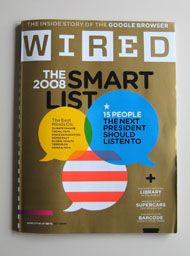 
-
An exhibition in New York's MOMA about "modernist's oldest dream": prefabrication and complemented sometimes by ility. The exhibition includes contemporary projects in prefabrication and digital building.
Full article HERE (pdf).
Friday, October 17. 2008

Fabricateurs d'espaces
17 October 2008 - 4 January 2009
-
Björn Dahlem, Jeppe Hein, Vincent Lamouroux, Guillaume Leblon, Rita McBride, Evariste Richer, Michael Sailstorfer, Hans Schabus
-
Curator: Nathalie Ergino ; assistant curator: Aude Merquiol
Institut d'art contemporain
Villeurbanne – Lyon
11, rue Docteur Dolard
69100 Villeurbanne
-
http://www.i-art-c.org
The Institut d'art contemporain presents a new generation of artists on the European scene who are concerned by questions of sculpture in the broad sense.
Differing from the sculpture of the past decade with its mainly post-ready-made techniques or assemblies of recovered materials, this new 'extended sculpture' simultaneously forms set-up, installation and architecture and uses space as the actual material for sculpture.
Fabricateurs d'espaces groups eight internationally reputed artists. The works shown are recent or made for the occasion. Sculptors of space or 'spacers', these artists use a vocabulary of forms derived from minimal art or land art.
The many meanings of space are explored - space generated by the body of the spectator, architectural space, mental and imaginary space, cosmic space, etc. Space is probed, constrained, gone beyond and reinvented.
These artists use the actual gestures of sculpture to make space interact with the material nature of their works, works that paradoxically generate the immaterial.
Here, the quest for 'elsewhere' is not necessarily on a cosmic scale but accompanies a wish to be free of gravity. The philosphical and perceptual approach that runs through the artistic approaches and works in this exhibition addresses the notion of Utopia and the quest for a future in the process of reinventing itself.
This exhibition is the fruit of a partnership with the Museum für Gegenwartskunst in Siegen, within the framework of the series of exhibitions entitled European Partners initiated by the Goethe-Institut and Kunststiftung NRW (North Rhine-Westphalia Art Foundation).
-
Institut d'art contemporain
11, rue Docteur Dolard
69100 Villeurbanne
T + 33 (0)4 78 03 47 00
F + 33 (0)4 78 03 47 09
iac@i-art-c.org
http://www.i-art-c.org
Image: Michael Sailstorfer
Unendliche Säule, 2006
Copyright: DR
|


